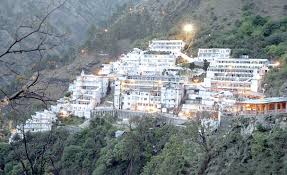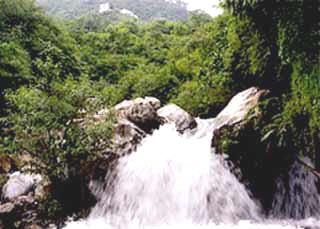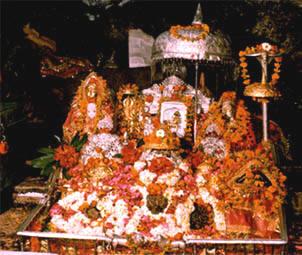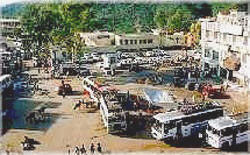|
Katra Town, lying in
the foot of Trikuta Mountains, 48 kms. from Jammu, serves as the
base camp for visiting the famous shrine of Shri Mata Vaishno
Devi, which is approachable on foot along a 13 kms long well
laid footpath. Every year, more than 4.5 million pilgrims pass
through Katra on their way to the holy shrine.
The cave shrine of
Mata Vasihnodeviji or Trikuta Bhagwati (alt: 5,200 ft.) has been
a beacon of faith and fulfilment to millions of devotees from
all over the world. The pilgrimage to the Shrine holds great
significance for the pilgrims.
The Legend of
Mata Vaishnodeviji.
|
 |
View of Vaishnodeviji from Bhavan
|
Everyday of the year
throngs of people surge up the steep pathways that cut across
the Trikuta hillsides for mile after mile. This show of faith is
finely interwoven with the cultural strands of the Indian
subcontinent, and these pathways have been trod on for many
centuries now. Popular belief holds that anybody who walks the
Himalayan trail to the goddesses's abode to ask for a boon
rarely goes back disappointed. Whatever be it, a new enterprise
or a forthcoming examination, marriage or birth, the devout look
up to the Mata For blessings and guidance. There are many who
journey year after year to pay obeisance regardless of their
faith or belief, creed or class, caste or religion.
The Yatra to the
holy shrine is as fascinating as the legend associated with it.
It goes that thousands of years ago, a comely maiden called "Vaishnavi"
have been created by the three lords attained human form and was
a devotee of Lord Vishnu. Having taken a vow of celibacy, she
spent almost all her life in meditation and prayers. In time she
attained enormous spiritual powers and is believed to have
extracted an assurance from Lord Rama that he will marry her in
Kali-Yug if she persisted in her spiritual quest.
This is why she is
also known as Adh Kanwari or the "eternal virgin".
Mata Vaishno Devi
established an ashram in the foothills of the Trikuta Mountain
and began to meditate. As predicted by Lord Rama, her glory
started spreading and people began to flock to her ashram to
seek her blessings. As time passed, a Tantrik called Gorakh Nath
(Demo God), who had a vision of the episode between Lord Rama
and Mata Vaishno Devi, became curious and wanted to know more
about her. Accordingly, he sent his most able disciple `Bhairon
Nath' to find out. Bhairon Nath started observing her secretly
and realized that despite being a `Sadhvi', she always carried a
bow and arrows and was always surrounded by langoor (apes) and a
ferocious looking lion. Bhairon, the demon God took a fancy to
her. But the Mata spurned his advances and fled to the Himalayas
to continue her spiritual quest.
|
 |
|
|
On the way the
goddess felt thirsty at Banganga and shot an arrow into
the earth from where water gushed out. Charan Paduka,
which is marked by the imprints of her feet, is the place where
she rested.
The Goddess then
meditated in the cave at Adh Kanwari. It took Bhairon
nine months to locate her, which is why the cave is known as
Garbh Joon.
When the demon found
her, Mata Vaishno Devi blasted an opening at the other end of
the cave with her trident and fled to the Holy cave at Darbar
(temple).
However, Bhairon was
persistent and followed her there to harass her. Then goddess
became very angry and assuming the form of Mata Kali, beheaded
Bhairon outside the cave with the aid of the flying disc gifted
to her by Lord Krishna
The severed head of
Bhairon fell at a distant hilltop. In his dying moments, Bhairon
begged and received divine forgiveness from the goddess. Today,
it is believed that the Yatra is not complete unless the pilgrim
has been to Bhairon ka Mandir (2.6 km from the main
sanctum) as well, after the darshan of Shri Mata Vaishno Devi.

The goddess herself
took up permanent abode in a cave in the Trikuta Mountains by
metamorphosing herself in to three pindis (Rock). This
holy shrine of Mata Vaishno Devi is unique as it contains the
holiest of holy Pindis manifesting the Mata in her three forms -
Maha Kali, Maha Lakshmi and Maha Saraswati - each form
representing a particular attribute. Maha Kali represents
Tamas Guna, Tamas meaning darkness. In her manifestation
of Kali the omnipotent, absolute and all pervasive, she is said
to be beyond fear and finite existence and is therefore able to
protect her devotees against fear and to give them limitless
peace. Maha Lakshmi represents Rajas Guna, Rajas
meaning prosperity. In this manifestation, the goddess blesses
her devotees with wealth and prosperity for living a better
life. Maha Saraswati represents Sattav Guna,
Sattav meaning wisdom and knowledge. This manifestation enables
her devotees to distinguish between good and bad and helps them
to adopt the right path in life. The combination of these three
attributes in a single Shakti is a unique combination, which is
what makes it, revered all over the world.
What to remember
-
Obtain a yatra
slip only from the yatra registration counter at the Tourist
Reception Centre at the Katra bus stand and nowhere else.
Without an authentic yatra slip, crossing of the Ban Ganga
check post is not permitted.
-
Take official
receipts for all payments made to the Shri Mata Vaishno Devi
Shrine Board (SMV Shrine Board) as well as those made to
private vendors. Demand to see official rate lists when making
payments.
-
Use only the
donation boxes provided by the SMV Shrine Board. In case of
donations at the donation counters of the board at Katra
(central office), Adhkawari, Sanji Chhat and various points at
the Bhawan and obtain a formal receipt for the same.
-
Donations to the
shrine are exempt from income tax under the Income Tax Act. Do
contact the central office of the Shrine Board located at
Katra, or the Sub Divisional Magistrate or Tehsildar in Room
No. 8, Kalika Bhawan, Durbar, or write to the Chief executive
Officer, SMV Shrine Board for any suggestions/complaints.
-
Avoid over
straining yourself on the climb. Walk on the paved track,
instead of the stairs. Do not relax at points where warning
notices are displayed. Do not break traffic discipline or try
to over take others at difficult stretches.
-
Good
accommodation, with bedding facilities is provided by the SMV
Shrine Board on payment. Facilities for booking of such
accommodation fixed rates are available at various offices of
the Board.
-
To maintain the
sanctity of the place do not indulge in playing cards, smoking
or chewing betel (paan) at Bhawan or enroute. Do not paint,
stick posters or disfigure signboards, and also avoid
littering the area.
-
Fellow pilgrims
are bound to you by their faith in the Mata. Avoid playing
transistors or tape recorders too loudly or creating blockage
or hindrances in the passages meant for circulation of the
yatris.
-
Qualified doctors
are available at the Primary Health Centre, Katra and at the
dispensaries at Adhkawari and Bhawan, round the clock. They
are also available at the evening clinic at Katra bus stand;
open 2 p.m to 8 p.m. Medical Aid Centres run by the SMV Shrine
Board provide necessary assistance to the pilgrims at the
Katra bus stand, Banganga and Sanji Chhat.
Clothing
Light woollens are
required at night even during summer. During the remaining parts
of the year heavy woollens are require.
How to reach
Jammu, 48 kms from
Katra, is the nearest airport, railhead and inter-state bus
terminus. Buses leave for Katra at 10 minute intervals between
5:30 a.m and 8:30 p.m. During peak season, additional buses are
pressed into service.
Taxis ar e
available both at Jammu and Katra for the journey. In Jammu
city, these can be hired from the Jammu airport, Jammu railway
station and the Tourist Reception Centre. A number of travel
agencies conduct tours to Katra regularly from Delhi and other
major cities of India. There are also daily scheduled services
to Katra from a number of cities and towns of Punjab, Haryana
and Himachal Pradesh. e
available both at Jammu and Katra for the journey. In Jammu
city, these can be hired from the Jammu airport, Jammu railway
station and the Tourist Reception Centre. A number of travel
agencies conduct tours to Katra regularly from Delhi and other
major cities of India. There are also daily scheduled services
to Katra from a number of cities and towns of Punjab, Haryana
and Himachal Pradesh.
Helicopter Service
Pawan Hans operates two flights daily from Jammu and 5 flights
from Katra to Shrine.
Capacity: 6 persons per flight. (The
service stands discontinued for the time being)
The distance from
Katra town to Vaishno Devi (Durbar) is 13 kms, which has to be
traversed by pony, ‘dandi’ or on foot. ‘Pithus’ (coolies) are
also available.
The Mata Vaishno
Devi Shrine Board (SMV Shrine Board) runs a large number of
cafeterias and viewing points along the trail between Katra and
the shrine where snacks, coffee and cold drinks are provided to
the yatris on a no-profit-no-loss basis. The Shrine Board also
runs ‘bhojanalyas’ at Katra, Adhkawari, Sanji Chhat and at the
Bhawan / shrine for providing hygienically prepared food to the
yatris on a no-profit-no-loss basis.
Upon reaching the
Bhawan, a group number is allotted to the pilgrims at the slip
(‘parchi’) counter against the yatra slip issued at Katra. The
yatri is required to stand in queue at Gate Number 2 till the
announcement of the group’s number is made to proceed to the
sanctum sanctorum. While inside the cave, one should concentrate
on the darshan of the mother goddess in her three-pindi forms –
Maha Kali, Maha Lakshmi or Maha Vaishnavi
and Maha Saraswati. The holy water coming from the feet
of the Mata can be collected on the way back.
|